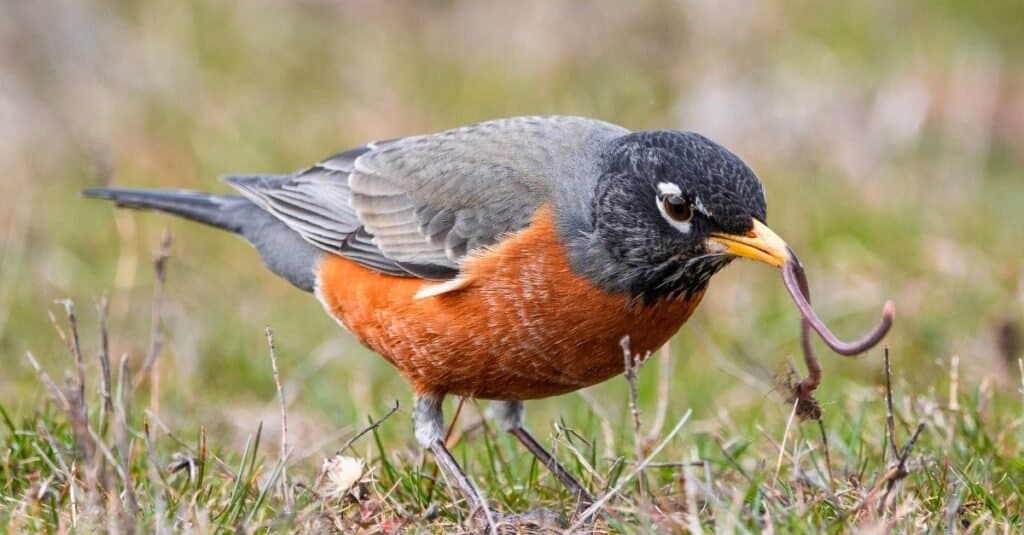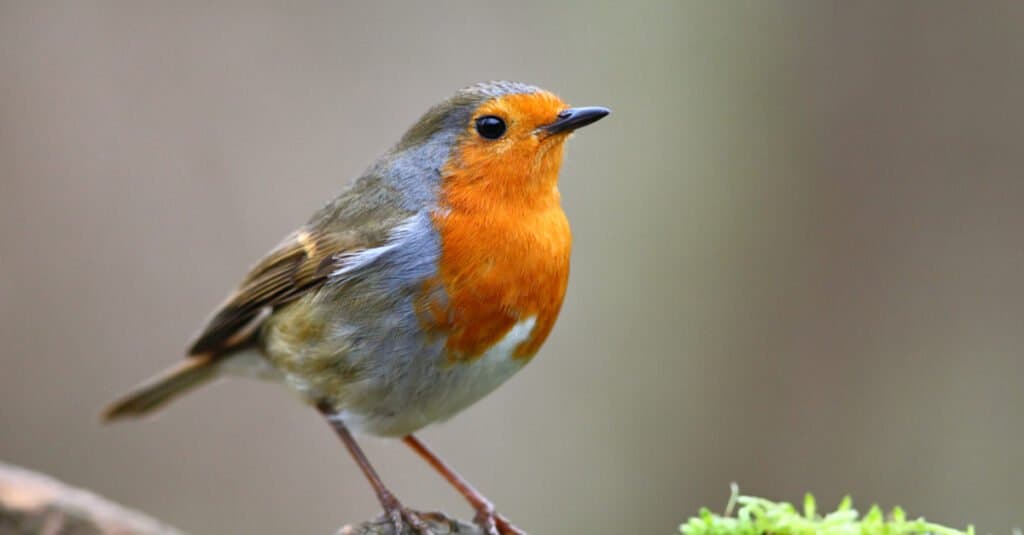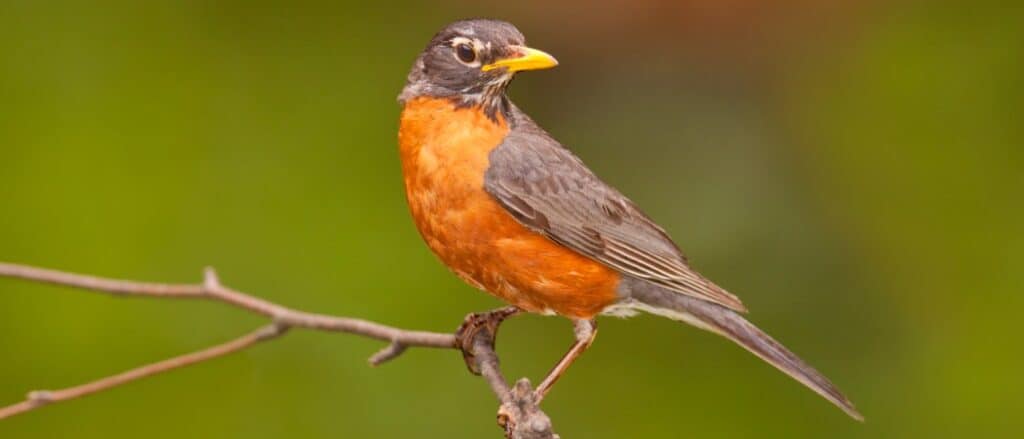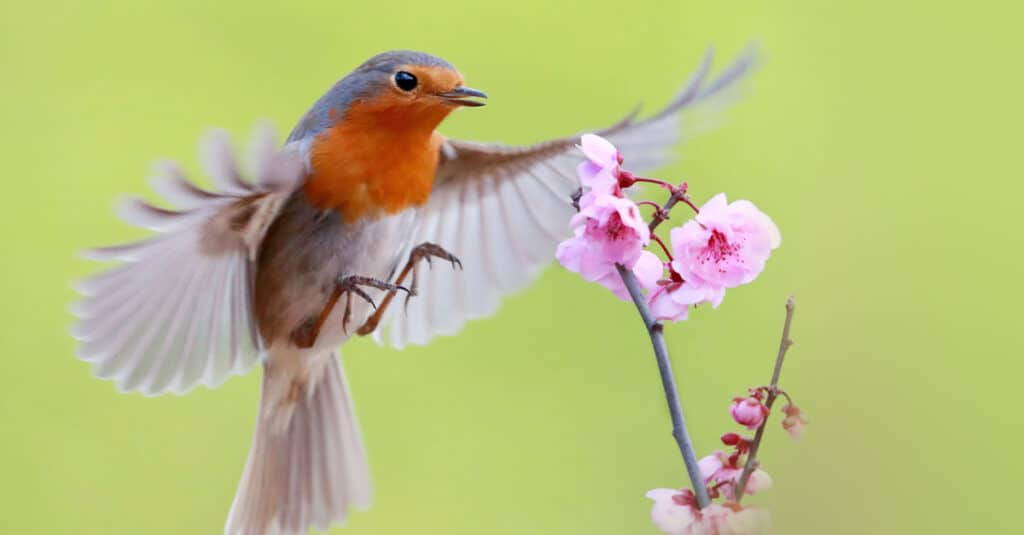The term “robin” applies to birds in various families with red or orange breasts, including the European robin and American robin. The European robin is an insectivorous passerine bird from the Old World flycatcher family.
The American robin is a migratory songbird from the wider thrush family. Although the two bird species are not closely related, the American robin is named after the European robin because of its reddish-orange breast.
Let’s examine all the differences between European and American robins to help you differentiate between the two.
Comparing European Robin vs American Robin
| European Robin | American Robin | |
|---|---|---|
| Classification | Kingdom- Animalia Phylum- Chordata Class- Aves Order- Passeriformes Family- Muscicapidae Genus- Erithacus Species- Erithacus rubecula | Kingdom- Animalia Phylum- Chordata Class- Aves Order- Passeriformes Family- Turdidae Genus- Turdus Linnaeus Species- Turdus migratorius |
| Size | Weight – 0.56 to 0.78 ounces Length – 4.9 to 5.5 inches Wingspan – 7.9 to 8.7 inches | Weight – 2.6 to 2.7 ounces Length – 8 to 11 inches Wingspan – 12 to 16 inches |
| Color | Brown, white, gray, orange | Gray, white, black, orange |
| Diet | Mainly feed on insects during the spring and summer but consumes fruits, berries, and seeds during winter | 60% of their diet consists of fruits and berries |
| Distribution and habitat | – Prefer living in gardens, woods, or farms – Found in Eurasia east to Western Siberia | – Woodland, shrubland, and residential areas – Found throughout most of North America |
| Reproduction and Life Span | – Breeding season begins in March, though some start courting as early as January – Female lays five to six eggs – The incubation period is approximately 13 days – The average lifespan is 13 months, though they may live longer | – Breeding season occurs between April and July – Females lay between three and five eggs – The incubation period is between 12 to 14 days – The average lifespan is two years |
| Vocalizations | Make a fluting, warbling sound during the breeding season. They sound more plaintive during winter. | Has a complex and almost continuous song often described as cheery carol |
The Key Differences Between European Robins and American Robins
There are numerous similarities and differences between European and American robins. The key differences between these two birds include classification, appearance, diet, habitat, reproduction, lifespan, and vocalization.
The European robin is a flycatcher thrush in the Muscicapidae family, which also includes Old World chats and nightingales. The American robin belongs to the Turdidae family, which also includes the wood thrush and the eastern bluebird.
Let’s discuss the key differences between European and American robins in more detail.
European Robin vs American Robin: Classification

American robins belong to the
Turdidaefamily.
©iStock.com/Mason Maron
The European robin (Erithacus rubecula) belongs to the genus Erithacus from the Old World flycatcher family (Muscicapidae). Erithacus is a Greek word for a type of bird, while the species name, rubecula, is a Latin word derived from ruber, which means “red.”
There are nine subspecies of European robins:
- E. r. melophilus
- E. r. rubecula
- E. r. tataricus
- E. r. marionae
- E. r. hyrcanus
- E. r. witherbyi
- E .r. caucasicus
- E. r. valens
- E. r. superbus
The American robin (Turdus migratorius) belongs to the Turdidae family. Its scientific name is derived from the Latin words “turdus,” which means thrush, and “migratorius,” meaning to migrate. There are seven recognized subspecies of the American robin, which intergrade with each other.
- T. m. migratorius
- T. m. nigrideus
- T. m. achrusterus
- T. m. caurinus
- T. m. propinquus
- T. m. confinis
- T. m. phillipsi
European Robin vs American Robin: Size

An adult European robin is 4.9 to 5.5 inches long and weighs approximately 0.56 to 0.78 ounces.
©Tomatito/Shutterstock.com
The American robin is much larger than the European robin. An adult European robin is 4.9 to 5.5 inches (12.5 to 14 cm) long and weighs approximately 0.56 to 0.78 ounces (16 to 22 g), with a wingspan of about 7.9 to 8.7 inches (20–22 cm).
The American robin stands between 8 and 11 inches (20.3 to 27.9 cm) in length and weighs about 2.6 to 2.7 ounces (73.7 to 76.5 g). It has a wingspan of 12 to 16 inches (30.5 to 40.6 cm).
European Robin vs American Robin: Color
Male and female European robins have similar plumage, which consists of an orange face and breast with a prominent bluish gray line on the sides of the chest and neck. The belly is whitish, the upper parts are brownish, and the bill and eyes are black. The legs and feet are brown.
Unlike European robins, the head of American robins varies from jet black to gray, with white supercilia. They also have reddish-orange breasts and a brown back. Their undertail coverts and belly are white, while the throat is white with black streaks. Also, their legs and feet are brown, like in European robins, but the bills are primarily yellow with a dark tip.
European Robin vs American Robin: Diet
European robins are primarily insectivores during spring and summer but feed on seeds, fruits, and berries in winter. On the contrary, 60% of the American robin’s diet mainly consists of fruits and berries. The other 40% primarily consists of insects, such as grasshoppers, caterpillars, beetle grubs, and earthworms.
European Robin vs American Robin: Distribution and Habitat

American robins are more common in woodlands, open farmlands, and urban areas.
©iStock.com/Silfox
European robins have a preference for parks, gardens, and spruce woods. They are mainly found in Europe, western Russia, northern Africa, and the Middle East.
American robins are more common in woodlands, open farmlands, and urban areas. They breed throughout most of North America, from Canada southward to northern Florida and Mexico.
European Robin vs American Robin: Reproduction and Lifespan
European robins breed in March, though a few species begin courting as early as January. Females lay between five and six eggs per clutch. The incubation period lasts roughly 13 days. European robins may live for 13 months, though they can exceed it.
The breeding season for American robins takes place between April and July. Females lay between three and five light blue eggs per clutch, which takes about 12 to 14 days to hatch. American robins molt once a year and may live for two years.
European Robin vs American Robin: Vocalizations

European robins produce a sweet, fluting, and warbling song during the breeding season.
©Wang LiQiang/Shutterstock.com
European robins produce a sweet, fluting, and warbling song during the breeding season. The high-pitched warbling melody transitions to a more melancholy sound in the winter.
On the other hand, American robins, like many thrushes, produce a complex and almost continuous song that is often described as a robust whistling melody that sounds like “cheerily, cheer-up, cheerily, cheer-up”, and is sung passionately in the spring.
Up Next…
- 10 American Robin Facts
- Robin Lifespan: How Long Do Robins Live?
- American Robin vs Oriole: What’s the difference?
The photo featured at the top of this post is ©
Thank you for reading! Have some feedback for us? Contact the AZ Animals editorial team.







